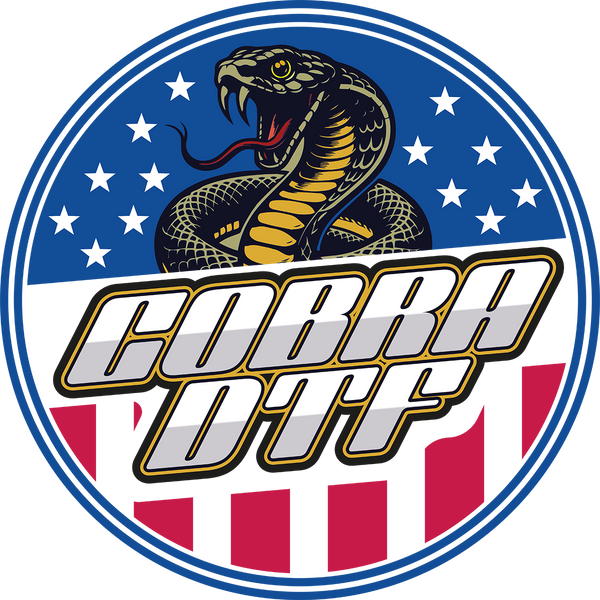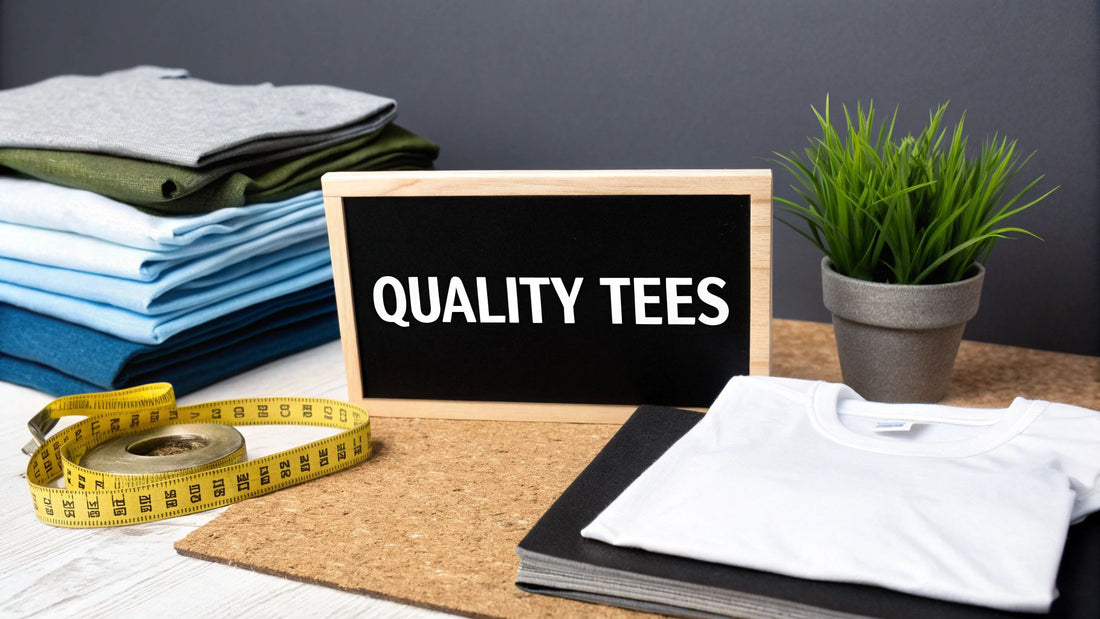
Choosing the Best Quality Tee Shirts for Printing
Share
Picking the best quality tee shirts for printing all comes down to one simple truth: the blank garment is your foundation. You can have the most incredible design in the world, but if you print it on a cheap shirt, you're setting yourself up for failure.
A top-tier shirt, something like a 100% combed and ringspun cotton tee from a brand like Bella + Canvas, makes your designs pop. The colors look richer, the print lasts longer, and the shirt just feels fantastic to wear. This single choice is probably the most important one you'll make for creating a product people will actually want to buy again.
Why Your Blank T-Shirt Choice Is Everything
Before your design ever makes it to the printer, you've already made the biggest decision for your brand. That decision is the blank tee you've chosen. A stunning design on a scratchy, poorly fitting shirt is a surefire way to get bad reviews and kill your brand's reputation before it even gets off the ground.
The blank t-shirt isn't just a canvas; it’s the heart and soul of your product. It’s what communicates value to your customer.
Think about it like this: you wouldn't pour a weak foundation for a new house. The same logic applies here. The quality of your blank directly affects a few key things:
- How your print looks: High-quality fabrics have a much tighter and smoother weave. This gives DTF ink a perfect surface to sit on, which means you get crisp lines and vibrant colors that truly stand out.
- How long the shirt lasts: A well-made shirt with details like double-needle stitching and shoulder-to-shoulder taping is built to survive the washing machine. It won't warp, twist, or fall apart after just a few wears.
- What your customer thinks: The second someone touches your shirt, they're forming an opinion. A soft, comfortable, well-fitting tee instantly screams quality and makes your price tag feel justified.
The Real Cost of Cutting Corners
I get it. It’s tempting to grab the cheapest blank you can find to boost your profit margins right out of the gate. But trust me, that's a classic rookie mistake that almost always backfires.
A customer who gets a shirt that feels like sandpaper, shrinks three sizes in the first wash, or has a side seam that twists around to their belly button is never coming back. Worse, they're probably going to leave a one-star review that scares other potential buyers away.
The real value of a premium blank isn't just in the few extra bucks you spend. It's in the customer loyalty it earns. Spending an extra dollar or two per shirt can easily turn into hundreds of dollars in lifetime value from a customer who loves your stuff and keeps coming back for more.
This visual breakdown really drives the point home, showing a premium shirt next to a budget one.
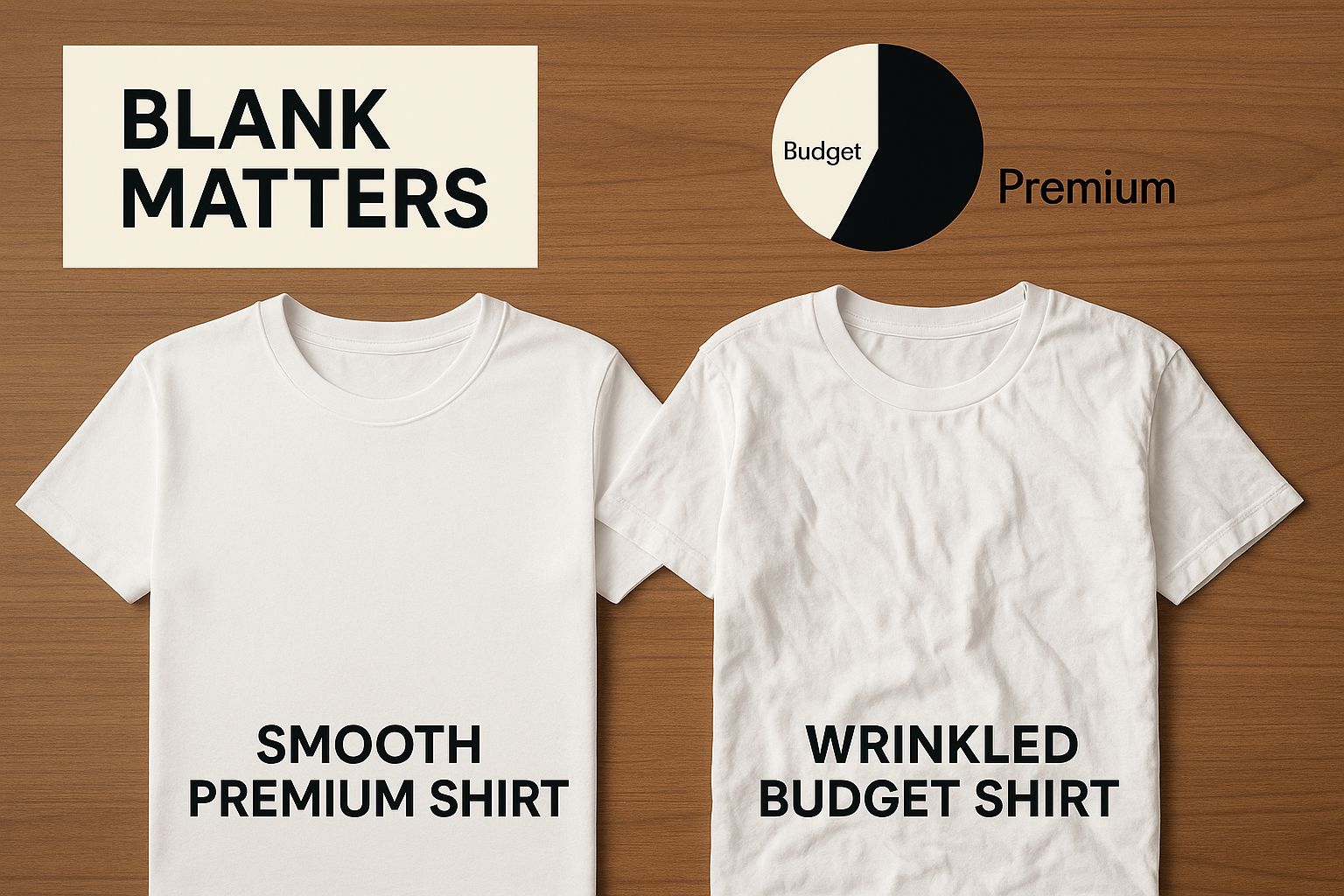
You can immediately see the difference. The quality blank offers a smooth, consistent surface that’s perfect for printing. The budget shirt looks wrinkled and uneven. This is the difference between a professional, retail-ready product and something that feels homemade in a bad way. Choosing the best quality tee shirts for printing isn't an expense; it's a direct investment in your brand's future.
Decoding Fabrics for Superior Print Results
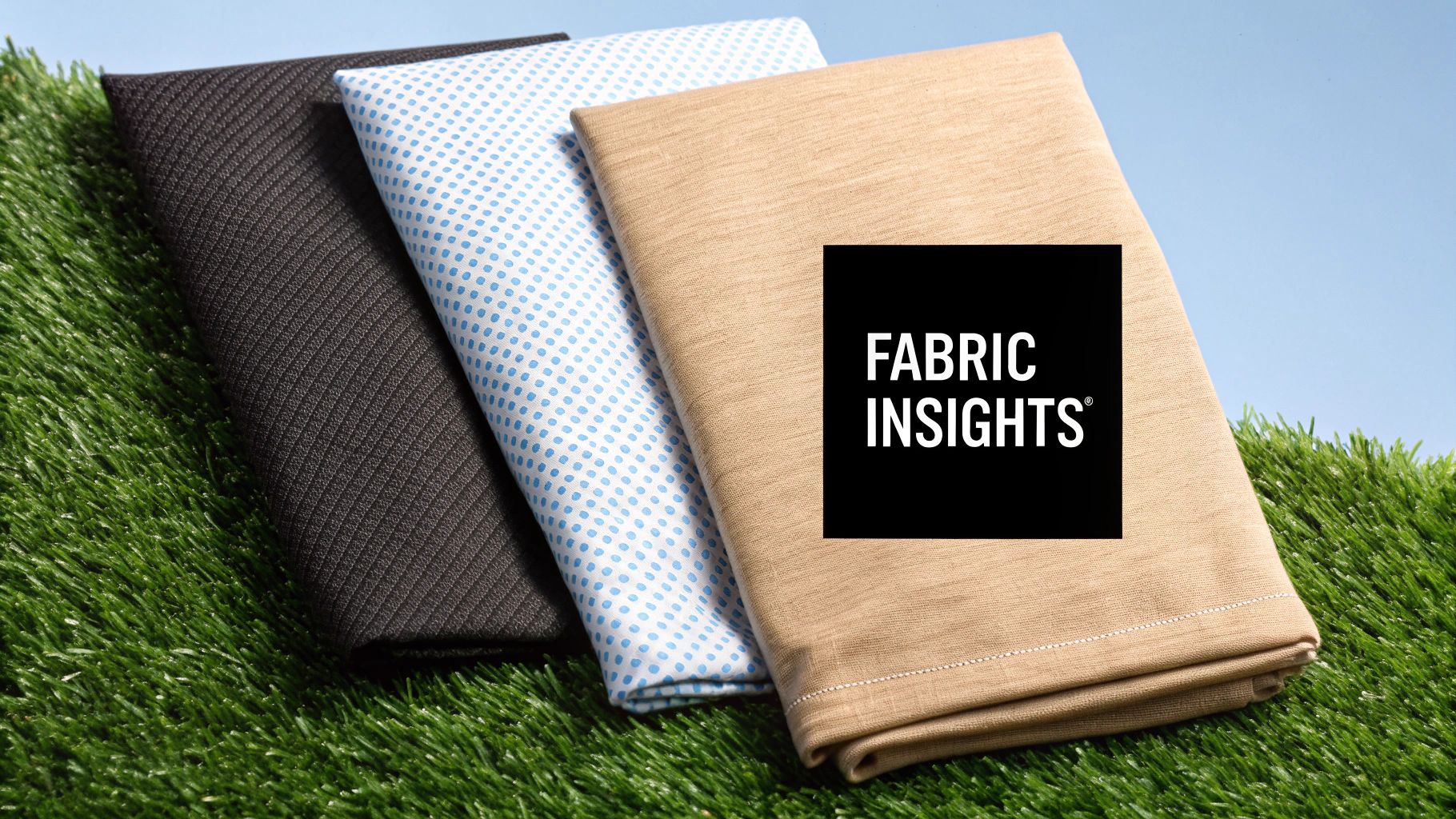
The single most important decision you'll make when choosing a t-shirt isn't the color or the brand—it's the fabric. This is the canvas for your art, and how it interacts with ink will make or break your final product. Get this wrong, and even the best design will look faded, fuzzy, or just plain cheap.
The custom apparel world is booming. The global market for custom t-shirt printing is expected to hit over USD 7.01 billion by 2025, and this growth is driven by printers like us who demand better quality. To keep up, you need to understand the materials you're working with. Check out the projected growth of the custom apparel market to see where things are headed.
Let's dive into the fabrics you'll encounter and figure out which one is right for your project.
The Gold Standard: 100% Ringspun Cotton
When it comes to DTF printing, nothing beats 100% combed and ringspun cotton. This isn't your average, scratchy, promotional giveaway tee. The ringspun process involves twisting and thinning the cotton strands to create a much finer, stronger, and softer yarn.
The result is a t-shirt with a super-tight, smooth weave. Think of it like this: trying to print on cheap, open-weave cotton is like painting on a chain-link fence. The ink sinks in, bleeds, and looks messy. Ringspun cotton, on the other hand, is like a freshly primed artist's canvas. The ink sits right on top, giving you those razor-sharp lines and vibrant, punchy colors you're looking for.
Key Takeaway: If you're chasing retail-quality results with photorealistic detail and brilliant colors, 100% combed and ringspun cotton is your non-negotiable starting point. It's the most reliable foundation for a premium print.
The Power of Polyester and Blends
While cotton is often the hero, don't sleep on polyester and blends. They serve very different purposes and can be the perfect choice depending on your goals.
-
100% Polyester: This is the undisputed champ for athletic apparel. It’s durable, wrinkle-resistant, and wicks moisture away from the skin. For printing, it’s the go-to for sublimation, a process where ink becomes a gas and fuses directly with the fabric fibers. For a full breakdown, explore our guide on choosing between cotton and polyester for printing.
-
CVC (Chief Value Cotton) Blends: These are typically a 60/40 cotton/polyester mix and offer a fantastic middle ground. You get the softness of cotton with the strength, shrink resistance, and slight stretch of polyester. CVC blends print well and often have that subtle "heathered" look that's so popular.
-
Tri-Blends: Made from cotton, polyester, and rayon, these shirts are ridiculously soft with a signature drape. The rayon gives them a uniquely fluid, almost silky feel. Printing on tri-blends produces a softer, more muted, vintage-style graphic. The ink sinks into the varied fibers differently, creating a perfectly worn-in look right off the press.
To make the choice easier, here's a quick cheat sheet comparing these common materials.
Fabric Comparison for T-Shirt Printing
| Fabric Type | Best For Printing | Feel & Comfort | Durability | Best Use Case |
|---|---|---|---|---|
| 100% Ringspun Cotton | Crisp, vibrant DTF/DTG prints. Excellent ink absorption. | Very soft, breathable, and gets softer with time. | Good, but can shrink or fade if not cared for properly. | Retail apparel, brand merchandise, high-detail graphics. |
| 100% Polyester | Sublimation. Resists ink absorption for a surface-level bond. | Smooth, lightweight, moisture-wicking. | Excellent. Resists shrinking, stretching, and wrinkles. | Athletic wear, performance gear, team jerseys. |
| CVC Blends (60/40) | Good for DTF. Provides a solid base with a heathered look. | Soft cotton feel with added stretch and durability. | Very durable. Less prone to shrinking than 100% cotton. | Everyday wear, budget-conscious retail, staff uniforms. |
| Tri-Blends | Creates a faded, retro/vintage print aesthetic. | Exceptionally soft, lightweight, with a signature drape. | Durable and holds shape well due to the blend. | Fashion-forward brands, vintage-style apparel, comfort wear. |
Ultimately, the best fabric comes down to matching the material's inherent qualities with the look you want to achieve and what your customers will love to wear.
The Truth About T-Shirt Weight and Construction
It’s one of the biggest myths in the apparel world: a heavier shirt is always a better shirt. While weight definitely plays a role, it's not the whole story. The real secret to a premium tee lies in the finer details of its construction.
Understanding this difference is what separates a decent blank from the best quality tee shirts for printing.
First, let's talk about weight. It's measured in ounces per square yard (oz/yd²) or grams per square meter (GSM). This number tells you the fabric's density, but it doesn't automatically translate to strength or softness.
- Lightweight (3.5-5.0 oz): Think soft, breathable, and flowy. These tees have a modern drape that's perfect for fashion-forward brands or anything you'd want to wear on a hot day.
- Midweight (5.0-6.0 oz): This is the go-to for most brands. It strikes a fantastic balance between solid structure and everyday comfort, making it a reliable workhorse for almost any project.
- Heavyweight (6.0+ oz): You'll find these in streetwear a lot. They offer a more structured, classic fit and are built to last, though they can feel a bit less breathable.
Why Construction Is King
Here's where the real expertise comes in. Two shirts can have the exact same fabric weight, but one can be vastly superior to the other simply because of how it was put together. A poorly made heavyweight shirt will still feel, look, and wear like a cheap shirt.
The single most important construction detail to look for is side-seamed construction. This is a game-changer. It means the front and back panels of the shirt were cut and sewn together separately, creating a tailored, structured fit that actually follows the shape of a human body.
The alternative is tubular construction, where the body of the shirt is essentially a single tube of fabric. It’s cheaper to make, but it results in a boxy, awkward fit that often twists and distorts after the first wash.
Pro Tip: If you want a professional-looking product, side-seamed shirts are non-negotiable. They hang better, fit better, and give you a more stable canvas, which is crucial for making different t-shirt printing techniques look their absolute best.
The Small Details That Scream Durability
Finally, you need to play detective and look at the finishing touches. These small details are dead giveaways that a manufacturer cared about building a garment that lasts, not just one that was cheap to produce.
Two features are your best clues:
- Shoulder-to-Shoulder Taping: Look inside the shirt at the shoulder seams. A high-quality tee will have a thin strip of fabric sewn over them. This tiny detail reinforces a major stress point, preventing the seams from stretching or ripping over time.
- Double-Needle Stitching: Check the hems on the sleeves and the bottom of the shirt. You should see two parallel rows of stitching. This strengthens the hems, making them far more durable and less likely to unravel.
When you find a tee that ticks all these boxes—side seams, shoulder taping, and double-needle stitching—you've hit the jackpot. These features, far more than just the fabric weight, guarantee you’re printing on a solid foundation that screams quality and will keep your customers coming back.
Selecting a Fit That Your Customers Will Love
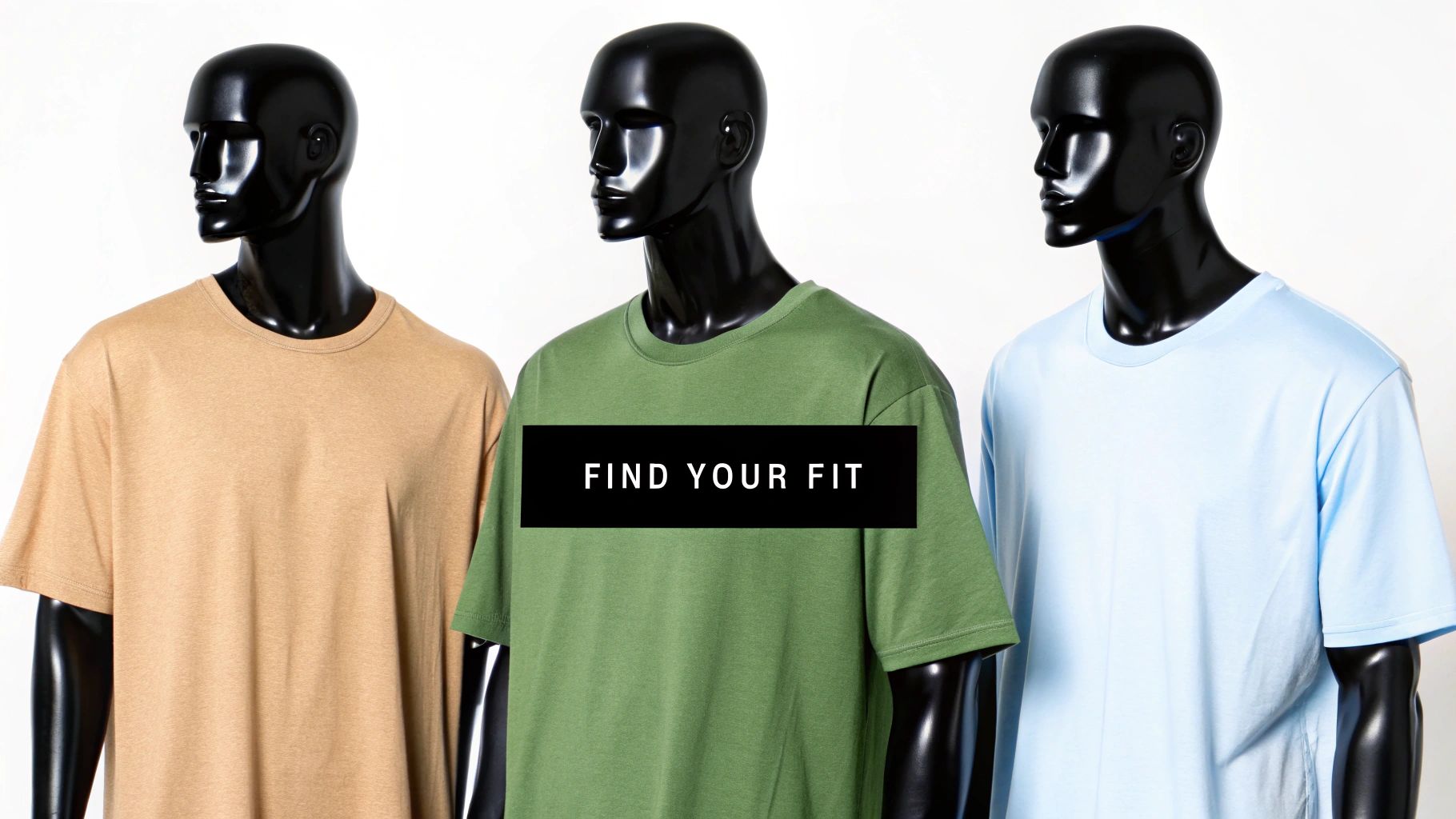
Let's be honest: a fantastic print on a shirt that fits badly is a total waste. The way a garment actually drapes on the body is just as crucial as the fabric itself. It’s the difference between a shirt someone wears once for an Instagram post and one that becomes a go-to in their weekly rotation.
Get the fit right, and you're not just selling a product; you're creating walking billboards for your brand. The silhouette you choose says a lot about who you are and who you're selling to, so understanding the subtle differences is key to picking the best quality tee shirts for printing that keep customers coming back.
Classic Fit vs. Retail Fit
Probably the first big decision you'll make is whether to go with a classic, boxy cut or a more modern retail fit. While the names might sound a bit alike, how they look and feel on a person couldn't be more different.
A classic fit tee, like the ever-popular Gildan 5000, is cut generously. Think straight, boxy lines through the body and looser sleeves. This style is built for a wide range of body types and is often the standard for things like promotional gear or workwear-inspired brands. The priority here is a relaxed feel, not a tailored look.
Then you have the retail fit (sometimes called a fashion fit). This is the style you see in most contemporary clothing stores. The Bella + Canvas 3001 is a perfect example. These shirts are constructed with side seams, creating a slightly tapered body, and they usually have shorter, more fitted sleeves. It’s a more flattering cut that most fashion-forward brands lean on for a premium, intentional look.
My two cents: If you're just starting out and feeling unsure, the retail fit is almost always the safer bet. It's what modern consumers expect from a quality garment, and it immediately gives your product a more premium feel that helps justify a higher price.
Decoding Size Charts and Dealing with Shrinkage
Never, ever just glance at a size chart and assume a "Large" from one supplier is the same as a "Large" from another. You have to dig into the actual measurements. The two most important numbers to look for are the body width (usually measured one inch below the armpit) and the body length.
Here’s what to zero in on:
- Body Width: This is the make-or-break measurement for fit. Compare the numbers on the spec sheet to a favorite t-shirt your ideal customer might already own.
- Sleeve Length: Shorter sleeves tend to look more modern and athletic, while longer, looser sleeves give off a more classic, relaxed vibe.
- Anticipating Shrinkage: Always plan for some shrinkage, especially with 100% cotton shirts. Even high-quality, "pre-shrunk" tees can still shrink up to 5% after the first few washes. Cheaper cottons can shrink a whole lot more.
Taking the time to check these details will save you from a mountain of customer complaints and costly returns. As the demand for custom apparel continues to skyrocket—especially in fashion-forward markets like the Asia Pacific region—getting the fit right isn't just a nice-to-have. According to some global t-shirt market trends, it's absolutely essential for success.
Making Smart Choices on Cost and Brand Value
It's a classic trap I see all the time in the apparel business: chasing the lowest-cost blank t-shirt to maximize profit. On paper, it makes sense, but this kind of short-term thinking can seriously backfire. The real game isn't just about slicing your cost per unit; it’s about building a brand that people trust and come back to again and again.
Spending a little more on a quality blank isn't just an expense—it's an investment that completely changes your pricing power. The moment a customer feels the difference between a standard, scratchy tee and one that's soft and well-made, they get it. That hands-on experience builds instant trust and makes a higher price tag feel justified.
A Real-World Cost Breakdown
Let's crunch some numbers to see how this actually works. Say you're weighing a budget-friendly blank against a more premium option for your next DTF print run.
-
Scenario A: The Budget Blank
- Cost per shirt: $2.50
- Print cost: $3.00
- Total Cost of Goods Sold (COGS): $5.50
- Retail Price: $18.00
- Gross Profit: $12.50
-
Scenario B: The Premium Blank
- Cost per shirt: $4.50
- Print cost: $3.00
- Total Cost of Goods Sold (COGS): $7.50
- Retail Price: $28.00
- Gross Profit: $20.50
Look at that. Even though the premium shirt costs $2.00 more upfront, it supports a $10.00 higher retail price. You end up pocketing $8.00 more on every single sale, and just as importantly, you attract customers who appreciate quality and are far more likely to become repeat buyers. This is how you build a lasting brand, not just move inventory.
The Power of Perceived Value
Perceived value is your secret weapon. It’s that gut feeling a customer gets when they hold your product. A shirt made from great fabric that doesn't get all twisted and weird after one wash sends a clear message: quality, durability, and attention to detail. That positive experience is a direct boost to your brand's reputation.
When you choose one of the best quality tee shirts for printing, you're really investing in your customer's happiness. That investment pays you back with repeat business, glowing reviews, and the kind of word-of-mouth marketing that money can't buy.
This creates a fantastic cycle. A happy customer turns into a loyal fan, which more than justifies spending a bit more on a better blank garment from the start.
Sourcing Smart Without Sacrificing Quality
Now, investing in premium blanks doesn't mean you have to blow your budget. It all comes down to sourcing intelligently. Start by building relationships with wholesale suppliers who offer tiered pricing—this can slash your costs as your order volumes grow.
Buying in bulk, whenever you can swing it, is one of the most powerful moves you can make. For more on this, check out our guide on how to reduce production costs for your apparel brand for some practical tips. Also, keep an eye out for suppliers with good sample programs. Testing a few premium options before you go all-in on a big order is the best way to find that sweet spot between cost and the amazing quality your brand stands for.
Answering Your Top Questions About Print-Ready Shirts
Alright, even after diving deep into fabrics and construction, a few specific questions always seem to surface right when you're about to pull the trigger on an order. Let's clear up some of the most common things I get asked by brand owners.
Getting these final details sorted out is what separates a good choice from a great one. It's about making sure the shirt you pick not only looks good but also works perfectly for your printing method and your brand's reputation.
For DTG Printing, What’s the One Thing I Absolutely Can't Compromise On?
If you're doing Direct-to-Garment (DTG) printing, the non-negotiable factor is 100% combed and ringspun cotton. Period. The ultra-smooth, tight knit of this fabric is the ideal surface for water-based DTG inks. It lets the ink sit perfectly, resulting in crisp lines and vibrant, punchy colors.
I've seen people try to save a few bucks by using standard, open-end cotton, and the results are always disappointing. It's like trying to paint on a fuzzy towel instead of a smooth canvas—the ink soaks in unevenly, details get lost, and the colors look dull. For that sharp, retail-quality look, premium cotton isn't just a nice-to-have; it's essential.
Does a Heavier T-Shirt Automatically Mean It's Better Quality?
That's a common myth, but no, not at all. A heavyweight tee (think 6 oz. and up) feels substantial and is definitely durable, but real quality comes from the refinement of the fabric and the construction of the garment. I'd take a lightweight 4.2 oz side-seamed shirt made from silky-smooth ringspun cotton over a thick, scratchy tubular-knit shirt any day of the week.
The right weight really boils down to the vibe you're going for.
- Heavyweight shirts are perfect for that classic, structured streetwear look.
- Lightweight shirts give you a softer, more modern drape that’s popular in fashion and retail.
The key takeaway? Don't judge a shirt just by its weight. Look closer at the stitching, the feel of the cotton, and how it’s put together. That's where you'll find the real markers of quality.
What's a Realistic Price for a Good Blank T-Shirt?
When you're buying wholesale, a genuinely good blank tee that’s ready for professional printing should land somewhere in the $4 to $9 range per piece. Where you fall in that range depends on the brand, the exact fabric blend, and how many you're buying at once.
Your basic, high-quality ringspun cotton tees will be on the lower end. Once you start getting into premium fabrics like tri-blends, or specialty washes like garment-dyed shirts, you'll creep toward the higher end. My advice? Be very skeptical of anything under $3. At that price, corners are being cut on fabric quality, construction, or both, and those compromises will show up in your final product.
I Keep Hearing About "Side-Seamed" Shirts. Why Is That a Big Deal?
It’s a huge deal for fit and quality. A side-seamed shirt is constructed the way tailored clothing is: with separate front and back panels that are cut and then stitched together along the sides. This process creates a garment that follows the natural curves of the body, giving it a much more flattering, structured fit.
The alternative is "tubular" construction, which is basically a single tube of fabric sewn shut at the shoulders. It’s faster and cheaper to make, but it results in a boxy, generic fit that’s notorious for twisting and warping after a few washes. If you want your brand to be associated with quality and a great fit, always, always choose side-seamed.
At Cobra DTF, we believe that a world-class print starts with a world-class transfer. Our American-made DTF transfers provide the vibrant color and durability your premium apparel deserves, helping you create products your customers will love. Explore our high-quality transfers and see the difference for yourself.
